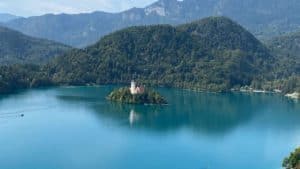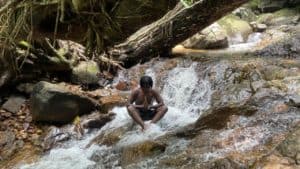If you love breathtaking landscapes and natural beauty, then Iceland will leave you in awe with its stunning cliffs, mesmerizing waterfalls, and awe-inspiring glaciers. However, there are definitely some things you need to know before you go. So, in this travel guide, we’re going to share 15 essential Iceland travel tips with everything you need to know before you go.
15 Essential Iceland Travel Tips
We spent 10 glorious days road-tripping around Iceland and we were blown away by all of the beautiful views around every corner. From the capital of Reykjavik to the wide open spaces on the ring road, with these 15 essential Iceland travel tips, you’ll be sure to get the most out of your visit!
Disclaimer: This post includes affiliate links. Buying through our links is at no extra cost to you, but it supports our website and our travels as we will receive a small commission. We really appreciate the support!
1. The Best Time to Visit Iceland

To witness Iceland’s vibrant waterfalls and picturesque landscapes, plan your visit during the summer months, between May and September. During this time, the lush green moss blankets the land, making it the perfect season for exploration. The extended daylight hours in June, with the sun setting as late as midnight and rising again at 3 am, allow for ample time to soak in the sights.
On the other hand, if you desire to witness the mesmerizing Northern Lights, schedule your trip for the winter months of November, December, and January. During this period, the long nights provide optimal darkness for seeing this natural light show. While you can venture out on your own to catch a glimpse of the lights, joining a tour is highly recommended. Tour companies possess expertise in weather patterns and will guide you to the best locations on the island for spotting this natural wonder, all while navigating the snowy conditions with finesse. So, schedule your Northern Light Tour here!
Moreover, you can also enjoy the Northern Lights from the Blue Lagoon or Sky Lagoon, which combines these fantastic attractions into one unforgettable experience.
2. What to Bring and Wear in Iceland

First and foremost, pack a reusable water bottle. Iceland boasts some of the most delicious tap water in the world, so take advantage of this and save money by refilling your own bottle. Furthermore, considering the overall cost of things in Iceland, skipping the purchase of bottled water is a small way to be mindful of your expenses.
When it comes to clothing, layering is key. During our trip in May, temperatures fluctuated between 38° and 48° Fahrenheit (3°- 8° Celcius). Even in June, when temperatures reach their highest of 55° F (12° C), it is essential to be prepared for cooler weather.
We discovered that a combination of a merino wool base layer, a puffer jacket or fleece, and a waterproof outer layer was ideal for combating the cold. For the lower body, we recommend wearing fleece leggings, water-resistant hiking pants, and rain pants as needed. Additionally, don’t forget to pack merino wool socks for extra warmth.

While an umbrella may seem useful, it is important to note that Iceland’s wind can be relentless, rendering umbrellas ineffective. Therefore, investing in high-quality waterproof jackets, pants, and shoes is crucial to ensure your comfort.
If you plan to visit during the winter months, crampons for your shoes are a must-have. Crampons provide traction on slippery surfaces, such as on the ice and snow when you walk to numerous waterfalls and beaches. You can find affordable and portable crampons on Amazon. Just know that crampons are unnecessary during the summer season.

For those traveling in summer, an eye mask is a valuable item to include in your luggage. With sunset as late as 10 pm or even midnight, and sunrise as early as 3 am, sunlight can interfere with your sleep. Bringing an eye mask will enable you to block out the light and enjoy a restful night’s sleep.
3. How to Get Around Iceland?

When it comes to getting around Iceland, there are three main options: taking a tour, renting a car, or driving a campervan.
Taking a tour is a convenient choice as it relieves you of the worries associated with road conditions and navigation. You can opt for day trips from Reykjavik or embark on a complete tour around the island like we did! The beauty of a tour is that you can simply sit back, relax, and enjoy the magnificent views, capturing photos and videos wherever and whenever you please.
See below for some incredible day trip recommendations.
Renting a car is great as well because it provides you with the flexibility to travel at your own pace and stay as long or as short as you desire in each destination. If you’re traveling between late May and September, the roads are generally easy to navigate, and you can rent a basic economy vehicle. I was pleasantly surprised to discover that car rentals in Iceland can be quite affordable if you know where to look. Click here to find the cheapest rental cars in Iceland.
As long as you stick to the Ring Road (Route 1), a basic economy vehicle will suffice. However, if you plan to explore remote trails on the F-roads or mountain roads, you’ll need a 4-wheel drive SUV with high clearance. Some F-roads involve river and stream crossings that necessitate a vehicle with sufficient clearance. Additionally, expect gravel, rocky terrain, and occasional sandy patches along these routes.
Keep in mind that F-roads lack facilities such as restrooms, gas stations, or hotels. Due to the risks and isolation associated with these roads, it is illegal to drive them in any type of passenger vehicle, including 4WD passenger vehicles. Only high-clearance 4×4 vehicles are permitted. However, it’s important to note that F-roads are limited in number and not essential for an incredible Icelandic experience.
If you enjoy camping, renting a campervan is another excellent option. A campervan offers the ultimate flexibility because there are numerous campsites around the island and campsite reservations are not necessary. This adds a sense of adventure to your journey because you can be more spontaneous and sleep at whichever campsite is closest after a day filled with fun activities.
Regardless of the mode of transportation you choose, it is crucial to stay updated on the weather conditions daily. You can bookmark websites such as https://safetravel.is/ and https://www.road.is/ to check if any roads are closed. During the winter months in particular, roads frequently close due to storms or poor conditions.
4. Taxis are Expensive!

Keep in mind that taxis in Iceland can be quite costly, with a one-way ride from the airport to the capital city of Reykjavik potentially setting you back $100 USD. To save money, I highly recommend booking an affordable airport transfer with Flybus, which can transport you to the capital for around $25-$30 USD.
If you plan on renting a car, it’s possible that you may need to take a taxi to reach your car rental agency. Take this into account when budgeting for your trip, or you should consider booking with a rental agency that offers a free shuttle service from the airport.
5. The Best Things to Do in Iceland

Iceland offers a wealth of activities and attractions to explore. Be sure to visit the capital city, Reykjavik, and take the time to experience the rejuvenating Blue Lagoon. Embark on a whale-watching tour to catch a glimpse of the 23 different species of whales found off the coast of Iceland.

Don’t miss the opportunity to visit the Snaefellsnes Peninsula, where you can marvel at the stunning Arnarstapi Cliffs and Kirkjufellfoss waterfall. Explore the mesmerizing lakes, lava fields, and waterfalls in the North, while the Southeast is home to glaciers and the captivating Diamond Ice Beach. The Southwest boasts picturesque waterfalls and black sand beaches, while the Golden Circle offers a popular tourist route filled with remarkable sights. Watch our full playlist of things to do in Iceland here!
6. Stay on the Trails

It is essential to stay on designated trails wherever you go in Iceland. This practice is crucial for preserving the beautiful green moss that blankets the country’s landscape. The growth of this moss is a slow process, taking up to 70 years to fully regenerate if damaged. By avoiding stepping on it, you can contribute to its preservation and ensure that future visitors can also enjoy its beauty.
7. Unique Foods to Try in Iceland
One unique Icelandic delicacy worth trying is the fermented shark. Unlike anything we’ve ever tasted before, it initially resembles ham but leaves behind an alcoholic aftertaste. It’s a fascinating culinary experience and a must-try if you enjoy exploring distinctive foods while traveling.
Another Icelandic food staple you’ll encounter is skyr, a thick yogurt often found on breakfast buffets. Make sure to indulge in this delicious treat while you’re in Iceland.
Of course, you can’t miss out on the fresh and flavorful fish in Iceland. With numerous fishing villages dotting the coast, the fish is incredibly fresh and should be savored in at least one of your meals during your stay.
8. How Expensive Is Food in Iceland?

To put it simply, food in Iceland is expensive. Even at regular eateries, a basic bowl of soup for lunch can cost around $17 USD, and a hamburger with fries and a drink at a gas station might set you back $20 USD. We came across a hotel buffet that charged $60 per person for dinner, which gives you an idea of the high cost of dining in Iceland. Needless to say, we opted not to eat at that hotel buffet.
9. Eat at a Gas Station
If you’re embarking on a road trip, one of my favorite Iceland travel tips is to eat at least one meal at a gas station. Surprisingly, gas stations in Iceland have decent cafeterias and restaurants that offer worthwhile dining experiences. Plus, most locals eat at gas stations when they are on a road trip. So if it’s a very local thing to do, then you definitely should try it too! While the food at gas stations may not be cheap, it’s a convenient and unique option for your road trip.
10. Book Everything in Advance
One essential Iceland travel tip is to book everything in advance. This is especially true for hotels, restaurants, and tours, as availability is limited and popular options tend to fill up quickly.
The only exception to this is campsite reservations. Campsites rarely reach capacity so you do not need to book them in advance. However, you might want to consider getting an Iceland camping card, which grants you prepaid access to over 40 different sites across the island. This can be a cost-effective option for those road-tripping around Iceland for a week or longer.
11. Is Iceland Safe?
Iceland is widely regarded as one of the safest countries in the world, with minimal incidents of petty crime. Tourist scams are virtually non-existent, although the high prices may lead you to think otherwise. Rest assured that both locals and tourists face the same elevated costs. This safety aspect allows you to explore Iceland freely without concerns about personal safety.
However, the primary safety considerations in Iceland revolve around the weather and driving conditions. If you plan to drive yourself, it’s crucial to monitor the weather regularly. Bookmarking sites like https://safetravel.is/ and https://www.road.is/ will help you stay informed about weather conditions and road closures. During winter, in particular, roads frequently close due to poor weather conditions.
12. The Currency in Iceland

Iceland has its own unique currency called the Icelandic króna (ISK). However, in reality, you don’t necessarily need to withdraw physical cash, as credit cards are widely accepted everywhere. I recommend having a credit card without foreign transaction fees and downloading a currency converter app. This way, you can easily translate currency exchange rates and keep track of your spending.
13. What Language Do They Speak in Iceland?
The primary language spoken in Iceland is Icelandic, which is known for being a challenging language to learn. However, you don’t need to worry, as English is widely spoken and understood throughout the country. That being said, it’s always appreciated to learn a few basic Icelandic phrases, such as “takk” which means “thank you.”
14. Outlets in Iceland
In Iceland, the standard electrical outlets use a two-prong Europlug and provide a voltage of 230 volts. It’s important to bring the appropriate adapter for your devices and ensure that they can handle the higher voltage. If you’re traveling from North America, like us, it’s crucial to verify that your devices are compatible with the higher 230-volt system. Most modern phones, computers, and cameras are designed to handle a wide range of voltages, but it’s always wise to double-check the specifications to confirm if your power adapter can accommodate voltages ranging from 110 to 230 volts.
15. Is Iceland Worth Visiting?

Definitely! Iceland is one of the most incredible places that we’ve ever visited, and it is definitely worth a visit. As you prepare for your trip to Iceland, keep these Iceland travel tips in mind to ensure an unforgettable experience because even though a trip to Iceland is expensive, it is most certainly worth every penny!
Learn even more about Iceland’s incredible destinations below!
- How to See Reykjavik in a Day
- Discover This Golden Circle Hidden Gem
- The Cheapest Way to Fly to Iceland
Pin this article for later!
The form you have selected does not exist.



